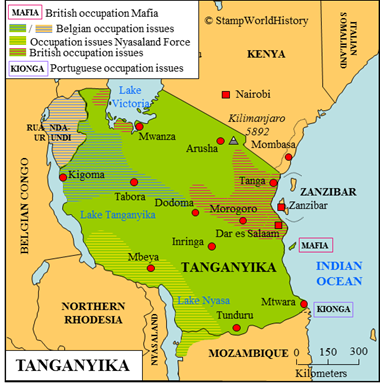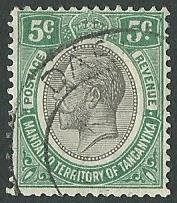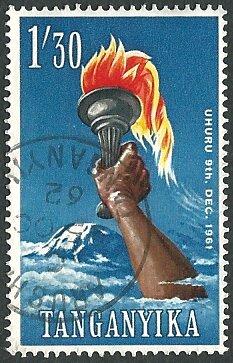
Tanganyika
British mandated territory

Tanganyika
Independent
Quick reference
General issues: British mandated territory 1921-1935, Independence within British Commonwealth 1961-1962, Republic 1962-1964
Country name on general issues: Tanganyika
Special issues: Occupation issues: Belgian occupation 1916-1922, British occupation 1917-1920, British occupation, Mafia 1915-1916, British occupation, Nyasaland Force 1916-1917, Indian Expeditionary Force 1914-1922,
Currency: 1 Pound = 20 Shilling, 1 Shilling = 12 Pence 1922-1964
Population: 4 341 000 in 1921, 11 390 000 in 1964
Political history Tanganyika
Tanganyika is located in eastern Africa. Tanganyika is the part of German East Africa that, after WWI, has become a British mandated territory. The Germans have been active in eastern Africa through the German East Africa Company from 1884. The first protectorates are formed in 1885, and when, in 1891, the administration of German East Africa is transferred from the German East Africa Company to the German government, German East Africa becomes a German colony.
During WWI, German East Africa is one of the major theaters of war outside of Europe. The first skirmishes take place in 1914. In 1915, the British occupy the island of Mafia to neutralize the German cruiser Königsberg. An all out attack is launched, in 1916, when the Belgians invade German East Africa from Belgian Congo, the British from British East Africa and from Northern Rhodesia and Nyasaland – the Nyasaland Force – and finally, the Portuguese from Mozambique. The German military command will capitulate in 1918.
In the 1919 treaty of Versailles it is agreed that German East Africa will be divided. Kionga – a small triangle on the border with Mozambique – is annexed by Portugal, Ruanda-Urundi becomes a Belgian mandated territory and the remainder of German East Africa becomes a British mandated territory, to be called Tanganyika from 1920. The Belgian withdrawal from Tanganyika – the Belgians having occupied territories well into the interior of Tanganyika – will take until 1921. The mandate of Belgium and Great Britain is formalized by the League of Nations in 1922. A mandate that is renewed in 1946 by the United Nations when Tanganyika becomes a United Nations trust territory.
In 1930, Tanganyika will join the East African Posts and Telecommunications Union, together with Kenya – the former British East Africa- and Uganda that had formed a postal union as early as 1902. The cooperation between the three countries, in subsequent years, will go by different names: from 1948, the East African High Commission, from 1961, the East African Common Services Organization and from 1967, the East African Community. The East African Community is dissolved in 1977.
Tanganyika will gain independence within the British Commonwealth in 1961 and becomes a republic in 1962. In 1964, Tanganyika and Zanzibar form the United Republic of Tanganyika & Zanzibar that, later in 1964, changes its name to Tanzania as we know it today.
Postal history Tanganyika
The first post offices in the future Tanganyika are opened in what is then German East Africa from 1890. The first stamps to be used are the stamps from Germany. The first stamps for German East Africa are issued in 1893. The last German post offices in German East Africa are closed in 1917.
During the Allied occupation of German East Africa, a range of stamps were issued for use in the occupied territories. In the future Tanganyika both Belgian and British occupation issues have been used as follows:
- The first issues to appear were those issued by the British occupation forces on the island of Mafia in 1915.
- More British occupation issues followed when the Nyasaland Force invading from Northern Rhodesia and Nyasaland issued stamps in 1916/1917.
- The British forces – that had invaded German East Africa from British East Africa and Uganda – issued stamps from 1917 until 1922.
- The forces from British India – operating from British East Africa – in their field offices used the British India issues for the Indian Expeditionary Force.
For a detailed description of these issues please refer to the country profile of German East Africa.
The first stamps for Tanganyika as a mandated territory are issued in 1921. These are still overprints on stamps of British East Africa & Uganda with the ‘G.E.A.’ overprint – for ‘German East Africa’ – the same as the occupation issues from 1917 and later years. The first set of definitives inscribed ‘Tanganyika’ is issued in 1922.
The stamps of Tanganyika will be used until 1935 when they are superseded by the joint issues under the flag of the East African Posts and Telecommunications Union – issues inscribed ‘Kenya, Uganda & Tanganyika’. Tanganyika – and later Tanzania – will use the joint issues of the East African Posts and Telecommunication Union and its successors until the East African Community is dissolved in 1977.
As is the case in Kenya and Uganda, Tanganyika will resume issuing stamps when it has gained independence – for Tanganyika in 1961. These issues will be used concurrently with the joint issues of the East African Community. Tanganyika will, after independence, issue only two sets in 1961 and 1962 respectively – these to be superseded in 1964 by the issues of the United Republic of Tanganyika & Zanzibar – one set issued in 1964 – and from 1965 by the issues of Tanzania.
Album pages
← Previous page: SwazilandNext page: Tanzania →





